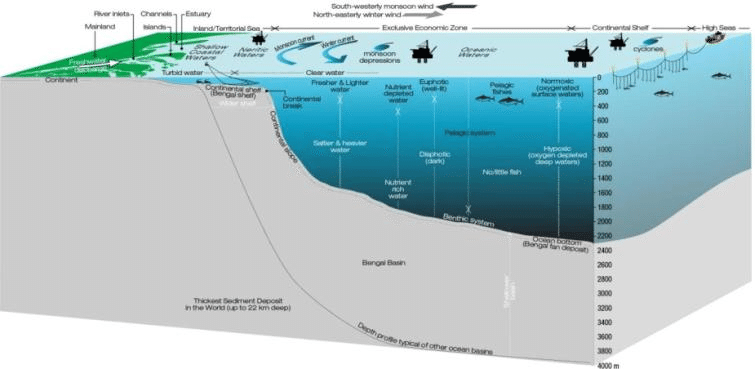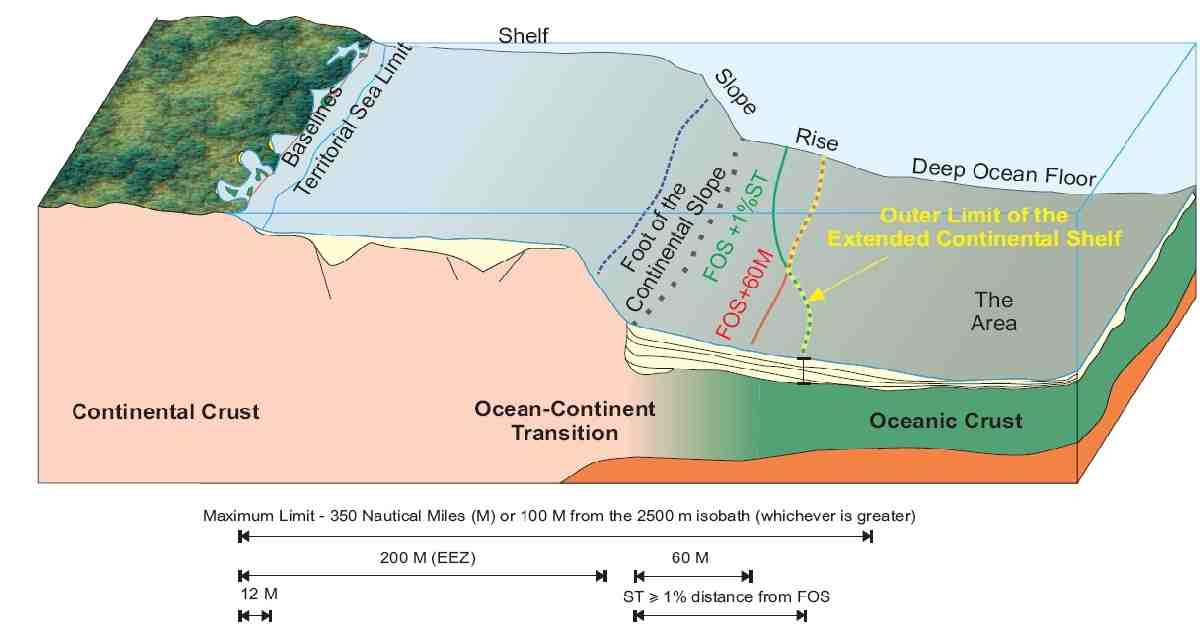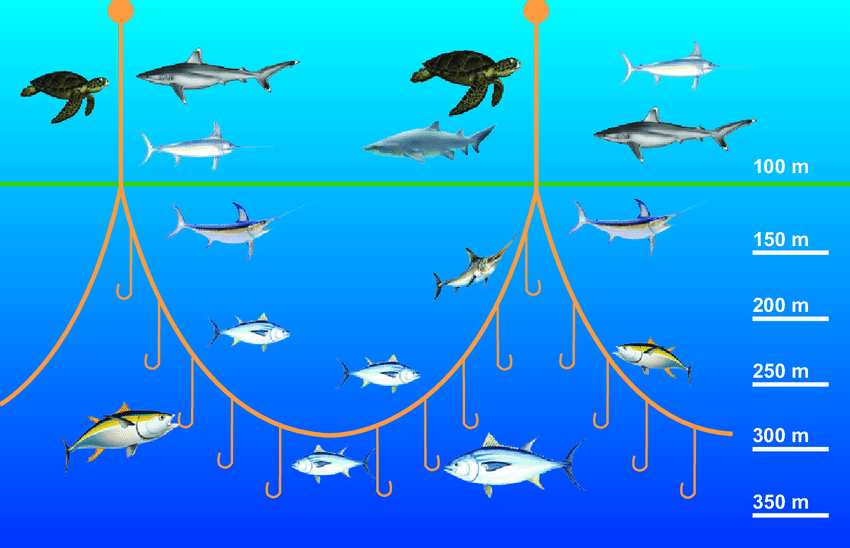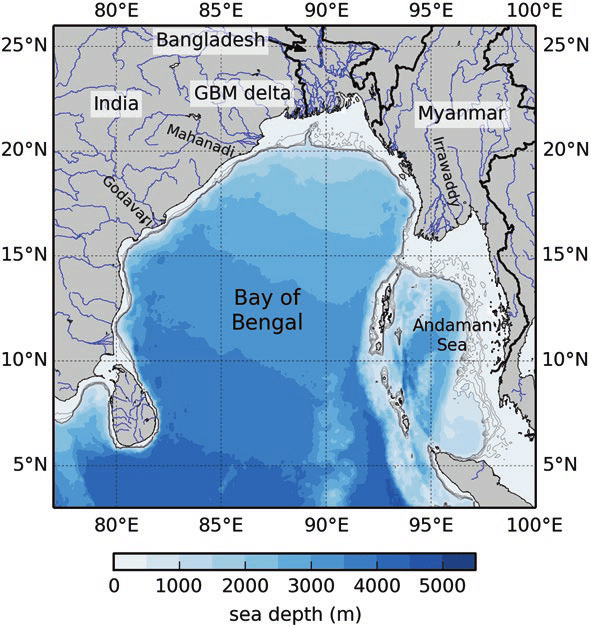Sea Bottom
The deep-sea bottom encompasses about 65% of the Earth’s surface, covering habitats showcasing high spatial heterogeneity in all dimensions (Zeppilli et al., 2016) and harboring tremendous biological diversity (Snelgrove, 1999). It usually begins at the shelf-break, about 200m depth in many parts of the ocean (Thistle et al., 2003). It is characterized by an extremely stable environment such as no light, high pressure and low oxygen level, temperature and food availability. Without any sufficient light to carry out photosynthesis, most marine sedimentary organisms at the bottom depend on phytoplankton and other organic materials sinking from surface waters above for food. Many benthic organisms have little to no mobility and are sessile (Snelgrove, 1999).

Figure 1: Salient characteristics of the marine system of Bangladesh. The actual depth profile of the Bay of Bengal (vertically exaggerated) and other elements not to scale (Hossain et al. 2014)

Figure 2: The Continental shelf of Bangladesh.

Figure 3: Deep sea long-line gear for fishing high-valued fish species (Hossain et al. 2017)

Figure 4: Overview of the Bay of Bengal, showing bathymetry and the location of features mentioned in the text. Contours are shown at 100 m intervals to 500 m; greater depths are shown by colour shading (Kay et al., 2018).
Due to the intense environmental conditions, sea bottom produced unique and highly adapted animals (Paulus, 2021). The megafauna at the sea floor consists primarily of demersal fishes, sea cucumbers, starfishes, brittle stars, and sea anemones whereas the macrofauna includes various polychaetes, bivalve mollusks, amphipods, and tanaid crustaceans. Additionally, numerous types of foraminifers, nematodes, and harpacticoid copepods are also found. According to Thistle et al. (2003), only 14 out of 300 species of stomatopods, also known as mantis shrimp, occur below 300m with more than 200 species of decapod crustacean fauna, predominantly brachyuran crabs, are found in shallow waters (<200 m). Below a depth of 1500 m, there are fewer than 40 species of decapods, and brachyurans make up ~10% of this total. The proportion of the bivalve mollusks that are eulamellibranchs decreases. In contrast, the proportion of isopod species that are asellotes and some bivalve mollusk species (protobranchs) increases with depth. Some organisms exclusively inhabit the deep sea, for instance, the protist group of xenophyophores has not been found above ~500m. Coldwater corals act as ecosystem engineers by forming unique habitats as they slowly deposit their skeletons on the seafloor, which are trapped in the sediment and ultimately build up larger reef structures (Paulus, 2021).
References
Hossain MS, Chowdhury SR, Navera UK, Hossain MAR, Imam B and Sharifruzzaman SM (2014) Background paper for preparation of the 7th Five Year Plan 2016-2020, Economic Relation Department, Ministry of Planning, The Government of Bangladesh, 67 pp.
Hossain MS, Chowdhury SR, Sharifuzzaman SM (2017) Blue Economic Development in Bangladesh: A policy guide for marine fisheries and aquaculture. Institute of Marine Sciences and Fisheries, University of Chittagong, Bangladesh, 32 pp.
Kay S, Caesar J, Janes T (2018) Marine Dynamics and Productivity in the Bay of Bengal. In: Nicholls R, Hutton C, Adger W, Hanson S, Rahman M, Salehin M (eds) Ecosystem Services for Well-Being in Deltas. Palgrave Macmillan, Cham. https://doi.org/10.1007/978-3-319-71093-8_14
Paulus E (2021) Shedding light on Deep-Sea Biodiversity—A highly vulnerable habitat in the face of anthropogenic change. Frontiers in Marine Science, 8. https://doi.org/10.3389/fmars.2021.667048
Snelgrove PVR (1999) Getting to the Bottom of Marine Biodiversity: Sedimentary Habitats: Ocean bottoms are the most widespread habitat on Earth and support high biodiversity and key ecosystem services. BioScience, 49(2), 129–138. http://www.jstor.org/stable/10.1525/bisi.1999.49.2.129
Thistle D (2003) The deep-sea floor: an overview. In: Tyler PA (ed.) Ecosystems of the Deep Oceans, Amsterdam: Elsevier, 5–38.
Zeppilli D, Pusceddu A, Trincardi F and Danovaro R (2016) Seafloor heterogeneity influences the biodiversity–ecosystem functioning relationships in the deep sea. Scientific Reports, 6(1). https://doi.org/10.1038/srep26352